Configure Appliances, Hubs, and Hub–Controllers
![]() For supported software information, click here.
For supported software information, click here.
The Deploy lifecycle allows you to configure and deploy appliances, hubs, and hub–controllers. You can perform the following tasks:
- Create an appliance, hub, or hub–controller node.
- Set, add, or change a profile on an appliance, hub, or hub–controller.
- Configure the bind variables for an appliance.
- Publish an appliance configuration to Versa Director.
- Activate appliances with ZTP.
- View configuration history.
Create an Appliance, Hub, or Hub–Controller node
To create a new appliance, hub, or hub–controller node in a site:
- In Tenant view, select the Deploy lifecycle in the left menu bar.
- In Honeycomb, Map, or Table view, double-click the site in which to create the new appliance or hub. The Site Summary screen displays.
- Click + Appliance, + Hub, or + Hub–Controller at the top of the screen.

- If you select + Appliance, enter information for the following fields.
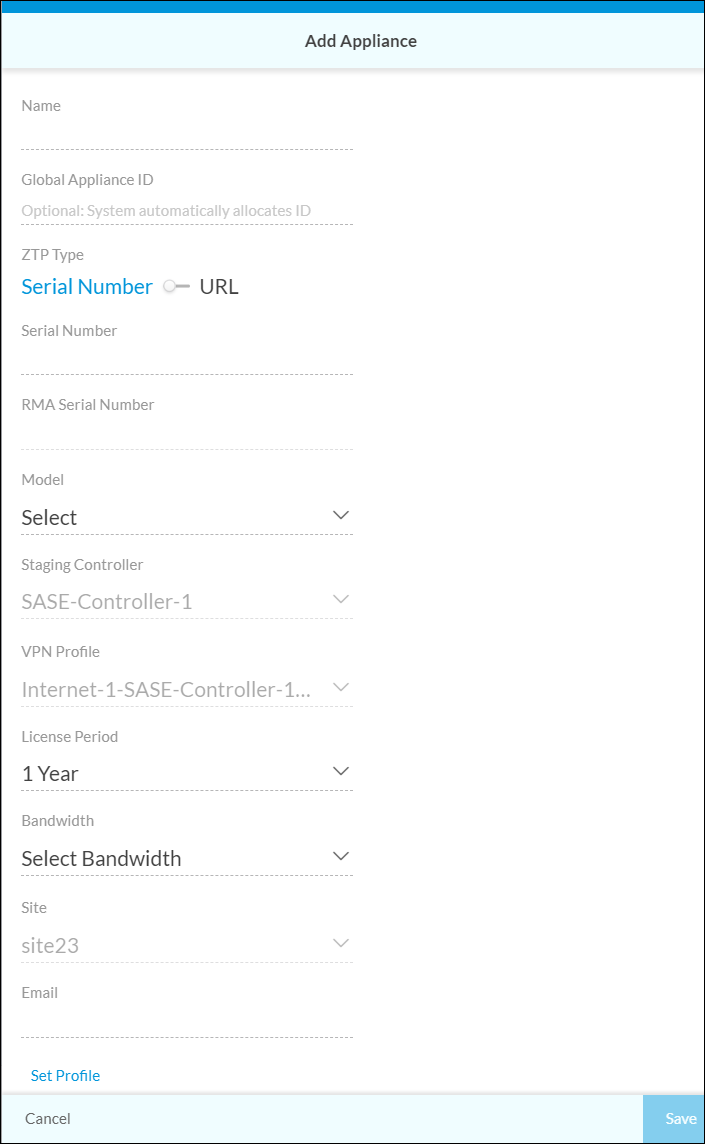
Field Description Name (Required) Enter a name for the appliance. Global Appliance ID Enter a global appliance ID number. If you do not enter an ID number, the system allocates one automatically.
Range: 101 through 16383
Default: None
ZTP Type (Required) Click to select perform ZTP on the appliance:
- Serial Number—Enter the serial number of the appliance.
- URL—Serial number is entered automatically.
Serial Number If you select Serial Number as the ZTP type, enter the serial number of the new appliance. RMA Serial Number Enter the RMA serial number for the device. For more information, see Update the Serial Number for an RMA Device in Concerto. Model Select an appliance model. Staging Controller Select a staging Controller node. VPN Profile Select a VPN profile License Period (Required) (For Releases 11.4.1 and later.) Select the period, in years, for which the license is valid:
- 1 year
- 3 years
- 5 years
Bandwidth (Required) Select the amount of bandwidth that the appliance can use. Site Displays the site name. Email Enter an email address for the site contact Set Profile Click Set Profile, select the profile, and then click Apply. You can also select the profile later.

- If you select + Hub, enter information for the following fields.

Field Description Name (Required) Enter a name for the hub. Global Appliance ID Enter a global appliance ID number. If you do not enter an ID number, the system allocates one automatically.
Range: 101 through 16383
Default: None
ZTP Type (Required) Click to select how to perform ZTP on the hub:
- Serial Number—Enter the serial number of the appliance.
- URL—Serial number is entered automatically.
Serial Number If you select Serial Number as the ZTP type, enter the serial number for the new hub. RMA Serial Number Enter the RMA serial number of the device. For more information, see Update the Serial Number for an RMA Device in Concerto. Model Select a hub model. Staging Controller Select a staging Controller node. VPN Profile Select a VPN profile. License Period (Required) (For Releases 11.4.1 and later.) Select the period, in years, for which the license is valid:
- 1 year
- 3 years
- 5 years
Bandwidth (Required) Select the amount of bandwidth that the hub can use. Site Displays the site name. Email Enter an email address for the site contact. Set Profile Click Set Profile, select the profile, and then click Apply. You can also select the profile later.

- (Releases 11.4.1 and later) If you select + Hub–Controller, enter information for the following fields.

Field Description Name (Required) Enter a name for the hub–controller. Global Appliance ID Enter a global appliance ID number. If you do not enter an ID number, the system allocates one automatically.
Range: 101 through 16383
Default: None
ZTP Type (Required) Click how to perform ZTP on the hub–controller:
- Serial Number—Enter the serial number of the appliance.
- URL—Serial number is entered automatically.
Serial Number If you selected Serial Number as the ZTP type, enter the serial number of the new hub–controller. RMA Serial Number Enter the RMA serial number of the device. For more information, see Update the Serial Number for an RMA Device in Concerto. Model Select a device model. Staging WAN Connection (Group of Fields) - Connection Name
Select WAN connection. If you have enabled staging, this WAN connection is used to perform ZTP on spoke appliances that use this hub–controller. A staging IPsec VPN profile is created for each of the staging-enabled WAN connections. - Staging
Click to enable the staging. - Pool Size
Select the staging pool size:
- 8
- 32
- 64
- 128
- 256
- Public IP Address
If the WAN connection has a public IP address that is different from the IP address of the interface, enter the public IP address of the WAN connection. - + Add Another
Click to add the staging WAN connection and to show the GUI fields to add another staging WAN connection. Click the  Delete icon to remove a connection from the list.
Delete icon to remove a connection from the list.Staging Controller If you have enabled URL ZTP for the hub–controller, select a staging Controller node. VPN Profile Select a VPN profile on the selected staging Controller node. License Period (Required) Select the period, in years, for which the license is valid:
- 1 year
- 3 years
- 5 years
Bandwidth (Required) Select the amount of bandwidth that the hub–controller node can use. Site Displays the site name. Email Enter an email address for the site contact. Set Profile Click Set Profile, select the profile, and then click Apply. You can also select the profile later.

- Click Save.
Configure a Layer 2 Wired Interface on an Appliance
For Releases 10.2.1 and later.
You can configure Layer 2 wired interfaces on an appliance. In addition, multiple Layer 2 wired interfaces can have the same Layer 3 integrated routing and bridging (IRB) interface.
To configure a wired Layer 2 interface on an existing appliance:
- In Tenant view, select the Deploy lifecycle in the left menu bar. The Sites tab is selected by default and displays all configured sites.

- Double-click a site to open it.

- Hover over an appliance hexagon, and then click View Configuration from the action menu. The Edit Appliance Configuration screen displays with the General tab selected by default.

- Select the Profile > Network tab, then click the LAN box.

- In the LAN screen, click Add Interfaces, then click Create New to add a new interface.

- In the Create Interface screen, select the General tab, and then enter information for the following fields.
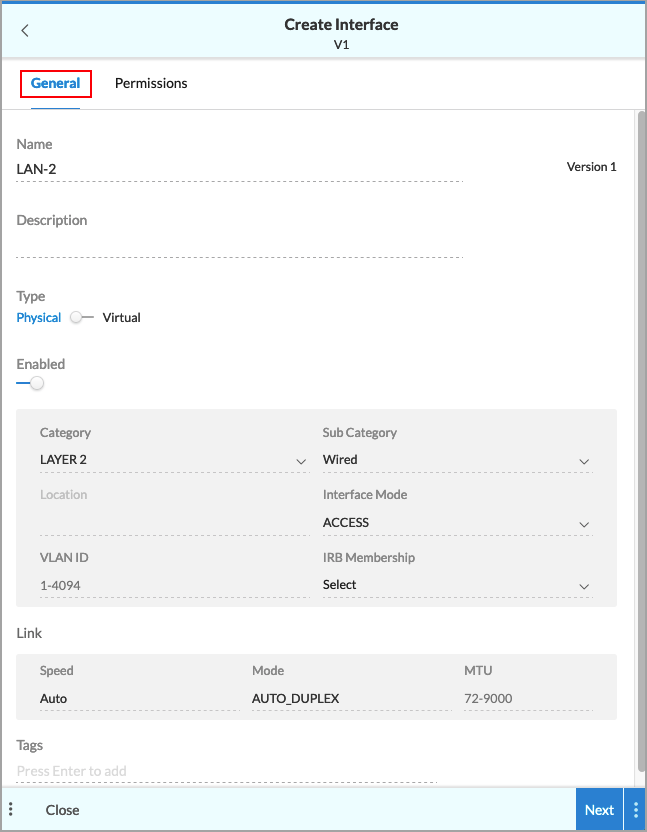
Field Description Name Enter a name for the Layer 2 interface. Type Select Physical as the interface Type. Enabled Click the slide bar to Enabled to enable the interface. Category Select Layer 2. Sub Category Select Wired. Location Select a VNI interface. Interface Mode Select Access or Trunk. VLAN ID If you selected the Access interface mode, enter a VLAN ID.
If you selected the Trunk interface mode, enter one or more VLAN IDs or VLAN ID ranges. Click the
 Check icon to add the VLAN ID or VLAN ID range. Click the
Check icon to add the VLAN ID or VLAN ID range. Click the  Delete icon to clear the VLAN ID field.
Delete icon to clear the VLAN ID field.Range: 1 through 4094
Default: None
IRB Membership (Access interfaces only.) Select an IRB of which the Layer 2 interface is a member. Link (Group of Fields) - Speed
Select a link speed for the interface:
- Auto
- 10 Mbps
- 100 Mbps
- 1 Gbps
- Mode
Select the link mode:
- Auto duplex
- Full duplex
- Half duplex
- MTU
Enter a maximum transmission unit (MTU) for the interface.
Range: 72 through 9000
Default: None
- Click Next, or click the Permissions tab and revise the permissions as desired.
- Click Save.
Configure a Layer 2 Wireless Interface on an Appliance
For Releases 10.2.1 and later.
You can configure Layer 2 WiFi interfaces on an appliance. In addition, multiple Layer 2 wireless interfaces can have the same Layer 3 integrated routing and bridging (IRB) interface.
To configure a WiFi Layer 2 interface on an existing appliance:
- Perform Steps 1 through 5 in Configure a Layer 2 Wired Interface on an Appliance, above.
- In the Create Interface screen, select the General tab, and then enter information for the following fields.

Field Description Name Enter a name for the Layer 2 interface. Type Select Physical as the interface Type. Enabled Click the slide bar to Enabled to enable the interface. Category Select Layer 2. Sub Category Select Wireless. Virtual Location Select WiFi, and then select a WLAN interface in the field to the right. IRB Membership Select an IRB of which the Layer 2 interface is a member. Radio (Group of Fields) - Frequency
Select a frequency for the interface:
- 2.4 GHz
- 5 GHz
- Profile Name
Select a profile name according to the frequency selected:
- Radio-2.4 GHz
- Radio-5 GHz
Tags Enter one or more tags. A tag is an alphanumeric text descriptor with no white space or special characters. You can add multiple tags for the same object. These tags are used for searching the objects. - Click Next, or click the Permissions tab and revise the permissions as desired.
- Click Save.
Configure an IRB Interface on an Appliance
For Releases 10.2.1 and later.
To create an IRB interface on an existing appliance:
- Perform Steps 1 through 5 in Configure a Layer 2 Wired Interface on an Appliance, above.
- In the Create Interface screen, select the General tab, and then enter information for the following fields.
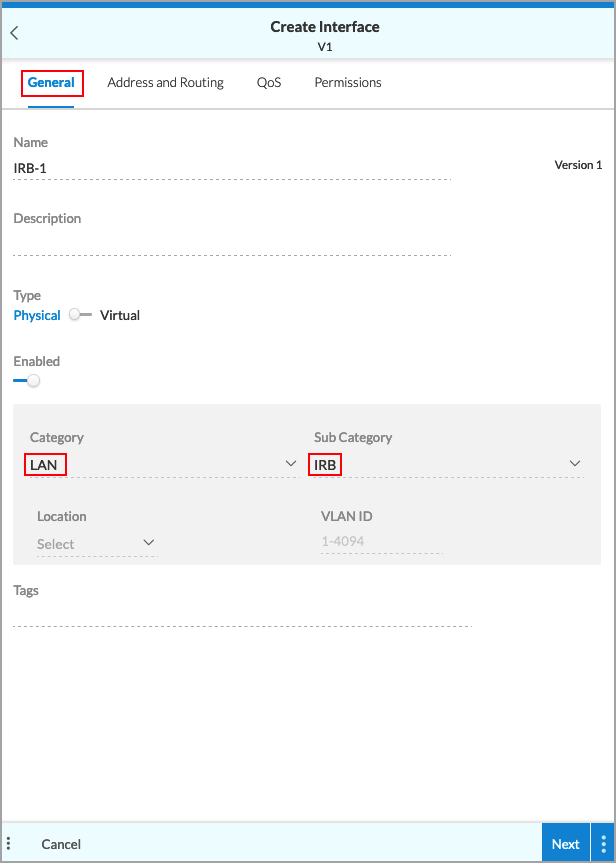
Field Description Name Enter a name for the IRB interface. Type Select Physical as the interface Type. Enabled Click the slide bar to Enabled to enable the interface. Category Select LAN or WAN. Sub Category Select IRB. Location Select an IRB location to which the IRB interface is a member. - Select the Address and Routing tab, and then enter an IPv4 address for the IRB interface.

- Click Next, or click the Permissions tab and revise the permissions as desired.
- Click Save.
Set, Add, or Change a Profile on an Appliance or Hub
After you create a site and add appliances to it, you add a profile to the appliances from the existing profile objects. You can add profiles from any of the Deploy lifecycle views—honeycomb, map, or table. You can change an appliance's profile using the same procedure.
To set, add, or change the profile for an appliance or hub:
- In Tenant view, select the Deploy lifecycle in the left menu bar.
- Select a site that has one or more appliances.
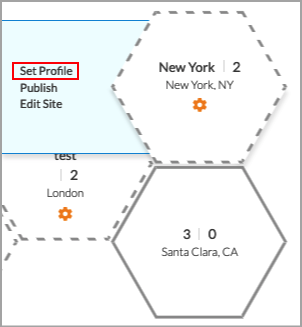
- To assign a profile to the appliances, click Set Profile. The Set Profile screen displays.
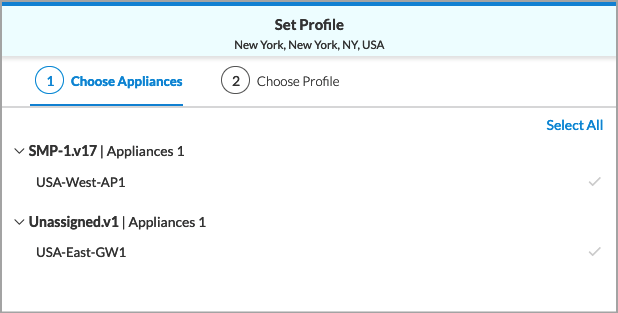
- Select one or more appliances, and then click Next. The Choose Profile tab displays.

- In the Search box, search for a profile, or select a profile from the list of available profiles. Note that you can apply different versions of the same profile to different appliances.
- Click Apply.
- To publish the new or changed profile for the site, select the Publish command in the Honeycomb, Map, or Table views.

When you modify a reusable object, such as a master profile, it becomes a custom version. Creating a custom profile does not create a new version of the master profile, and the change is not added to the repository of reusable objects.
For example, in the screenshot below, the profiles HQ-Device-Profile version 4 and WestCoast-Security version 2 have been modified, so the version is appended, as indicated by the word Custom.

To display summary information about a site, double-click the site. The Site Summary displays the profiles that are assigned to each site.

Download Profile Assignments in CSV Format
For Releases 11.3.2 and later.
You can download a report to a file in CSV format that shows which devices are assigned a specific profile, and also download a report that shows all the devices at a site and which profiles are assigned to them.
To download profile assignments reports to a file in CSV format:
- Go to the Deploy lifecycle. All configured sites display, along with a summary of all the sites in the right-hand pane.
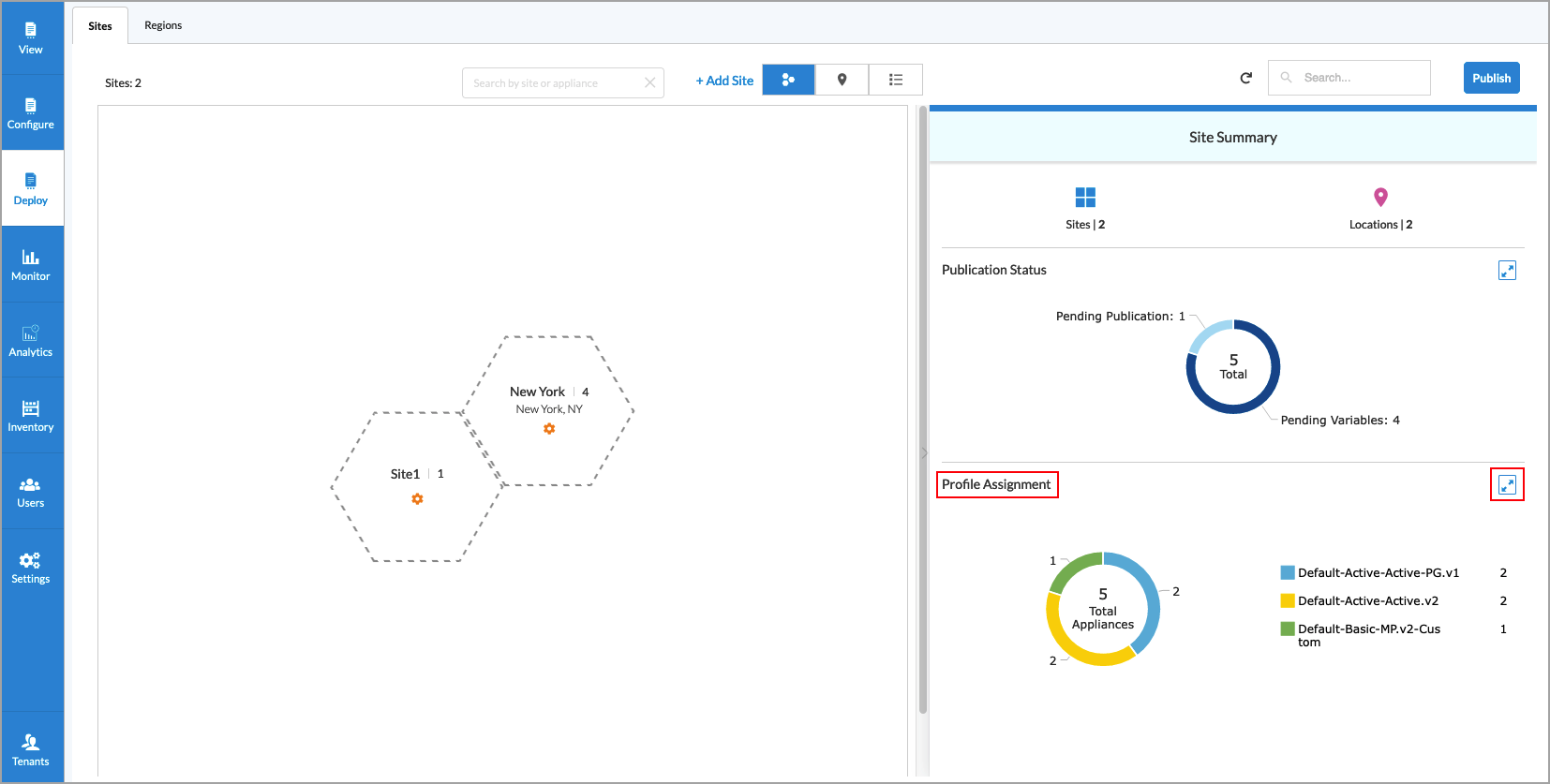
- In the Profile Assignment section of the Site Summary, click the
 Expand icon. The Profile Usage screen displays with the first profile in the list highlighted in the main pane and in the Summary pane (profile Default-Active-Active.v2 in the example below). You can click the name of a different profile in the main pane to see the details of the appliances assigned to that profile in the Summary pane.
Expand icon. The Profile Usage screen displays with the first profile in the list highlighted in the main pane and in the Summary pane (profile Default-Active-Active.v2 in the example below). You can click the name of a different profile in the main pane to see the details of the appliances assigned to that profile in the Summary pane.

- To download the summary information for the highlighted profile, click the
 Download icon in the Summary pane.
Download icon in the Summary pane.

The summary information downloads to a file in CSV format, similar to the following:

- To download a report that shows all the devices at a site and which profiles are assigned to them, click the
 Download icon to the left of the Publish button.
Download icon to the left of the Publish button.

The information downloads to a file in CSV format.
Configure the Bind Variables for an Appliance
After you add a master profile to an appliance, you enter any bind variable values in the master profile that are specific to the appliance. When you hover over the ![]() Gear icon in device's hexagon, a Pending Variables message indicates that a bind variable value has not been configured.
Gear icon in device's hexagon, a Pending Variables message indicates that a bind variable value has not been configured.

To configure bind variable values:
- Double-click the site hexagon for a site that has pending variables. The site-specific devices display. The screenshot here shows only one device at the site, USA-West-AP1.
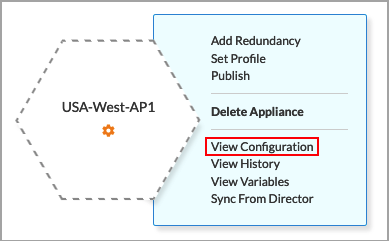
- In the action menu for the device, click View Configuration. The Edit Appliance Configuration screen displays.

- Hover over the Interface IP variable. The popup window shows that the value for LAN-1-Address is missing.
- Click the variable name. In the Variables window, enter a value for the missing variable. The screenshot here shows that the value is the IP address of LAN-1-Address.
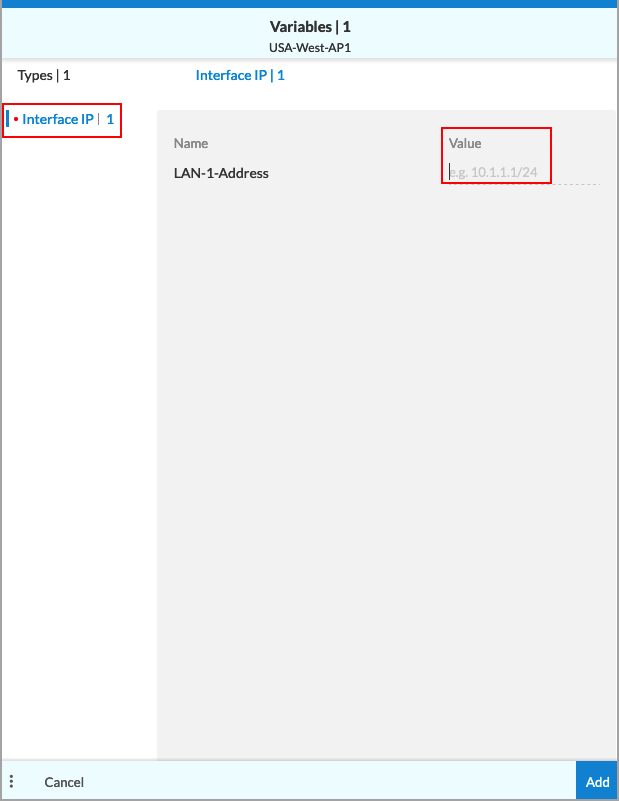
- Click Add. The Edit Appliance Configuration window displays again.
- Select the Permissions tab, and click Save to save the variable.
- On the Edit Appliance Configuration screen, click Save to save the updated master profile.
Publish an Appliance Configuration to Versa Director
When you have configured all the bind variable values, the appliance's publication state transitions to Pending Publication. This state indicates that the configuration changes have not been published to the Director node.

To publish the configuration changes to the Director node:
- Click Publish in the action menu. In Honeycomb view, a progress bar indicates the publication status.

- To display the publication task messages, click the progress bar.

When the configuration is published successfully, the Director node has all the configurations, including templates, device groups, and device hardware inventory, and is ready to start the ZTP process on the appliance.
Activate Appliances with ZTP
After an appliance's configuration is published, the Director and Controller nodes have all the configuration information needed to accept the appliance into the enterprise network. The appliance, either a physical or virtual appliance, is bootstrapped using the ZTP process based either on the serial number or the URL, depending on the configuration. When the appliance completes the ZTP process, the hexagon edge color in Honeycomb view changes from gray to blue, indicating that the ZTP process has completed and the appliance is now connected to the Director node.
View the Configuration History
You can view and compare the history of configuration changes made locally in Concerto. You can compare any two published configurations, and you can also compare an unpublished version with the last published version.
Note: You cannot compare configuration changes made in Versa Director.
To view the configuration history and compare versions:
- In the left menu bar, select Deploy to display all sites in Honeycomb view.
- Double-click a site hexagon, hover over an appliance hexagon, and click View History.

- The View History pane displays the configuration version history for the appliance.

- To compare versions of published configurations, click the checkbox next to the desired versions, and then click Compare. The Configuration Diff screen displays.

- To download a text file of a configuration, click the
 Download icon.
Download icon. - To view the differences between a published configuration and a current unpublished configuration, click the
Arrows icon to the right of one of the versions.

The Configuration Diff screen displays. The unpublished configuration is on the right and is labeled Current.

- Click Close.
Supported Software Information
Releases 10.1.1 and later support all content described in this article, except:
- Release 10.2.1 adds support for configuring Layer 2 wired and wireless interfaces and IRB interfaces on an appliance.
- Release 11.3.2 adds support for downloading a report to a file in CSV format that shows which devices are assigned a specific profile, and for downloading a report that shows all the devices at a site and which profiles are assigned to them.
- Release 11.4.1 adds support for configuring hub–controller nodes on appliances and choosing a license period option for appliances and hubs.
